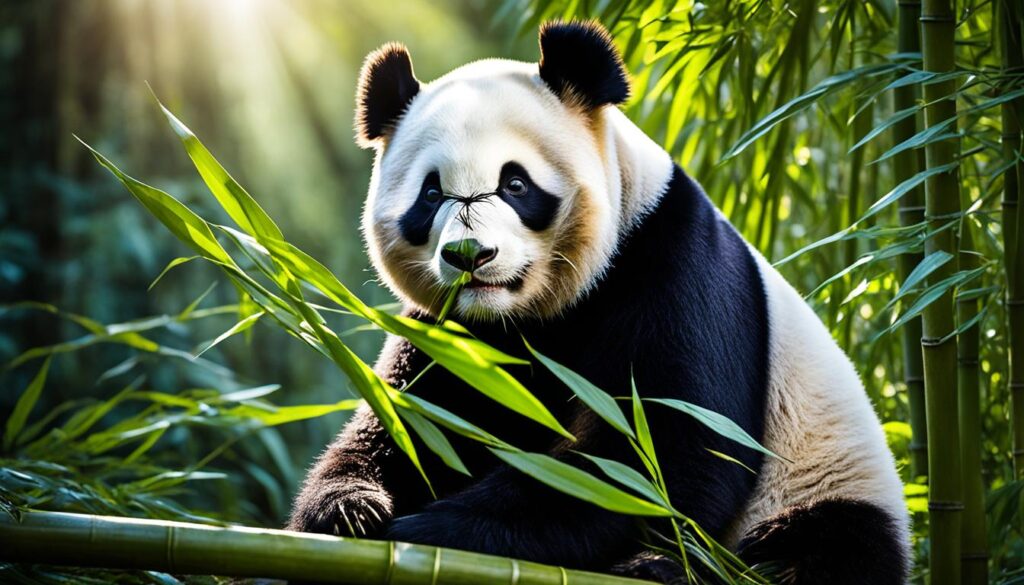The natural world is a delicate tapestry, where each species is crucial for our ecosystems’ balance. Sadly, many of these amazing creatures are in danger, on the edge of extinction. This article will focus on 10 endangered animals that need our help and attention.
From the majestic Bengal tiger to the elusive snow leopard, these endangered species amaze us with their unique traits and vital roles in nature. Understanding their challenges and the need to protect their homes is key to saving them. We can all help ensure their future and let future generations marvel at their beauty.
By highlighting these endangered animals, we aim to spark wonder, empathy, and a deep commitment to saving our planet’s diversity. Let’s join together on this journey to learn about these incredible creatures and how we can help them survive.
Introducing Endangered Wildlife
The Earth is filled with a wide variety of wildlife, each playing a key role in keeping our ecosystems balanced. But, many of these animals are now at risk of disappearing, known as endangered species. They face many challenges, like losing their homes, being hunted, and the effects of climate change.
Why We Should Care
Protecting endangered wildlife is crucial for our planet’s health and strength. These animals are vital to their ecosystems, helping with tasks like spreading seeds, pollinating plants, and controlling populations. Losing a species can have big effects, leading to a loss of biodiversity and ecosystem collapse.
The Importance of Biodiversity
Biodiversity, or the variety of life in a habitat or ecosystem, is key to a healthy and sustainable world. Losing endangered species weakens the ecosystem, making it more prone to diseases and pests. Protecting endangered wildlife is vital for our planet’s future health and resilience.
The Majestic Bengal Tiger
The Bengal tiger is a majestic creature, one of the most iconic and endangered on Earth. These felines are known for their orange and black stripes. They live mainly in the Sundarbans, which is in India and Bangladesh. Sadly, they face threats like poaching and losing their homes, which has made them fewer in number.
Despite these challenges, efforts to save the Bengal tiger are ongoing. The World Wildlife Fund (WWF) and the National Tiger Conservation Authority (NTCA) in India are leading these efforts. They work hard to protect the animals and their homes. Things like anti-poaching patrols, fixing up their homes, and working with local communities are key to saving the Bengal tiger.
The Sundarbans is a key place for saving the Bengal tiger. It’s the world’s biggest mangrove forest and a UNESCO World Heritage site. This special place is full of different plants and animals and is a key home for the Bengal tiger. Protecting the Sundarbans and its people has become more important as it faces threats from climate change, cutting down trees, and bad human actions.
Protecting the Bengal tiger and other endangered animals shows us how connected our planet is. We need to understand how important different kinds of life are for a healthy planet. By supporting conservation and living sustainably, we can help make sure the Bengal tiger stays in the forests and mangroves for the future.
The Gentle Giant Panda
In the lush bamboo forests of China, a special creature lives: the giant panda. This animal, with its black and white fur, has won the hearts of people everywhere. It’s a symbol of conservation and a key part of the bamboo ecosystem.
Bamboo’s Best Friend
The giant panda is known as a bamboo expert. These gentle giants eat bamboo for up to 14 hours a day. They use a special “thumb” made of an enlarged wrist bone to hold and eat bamboo.
They also have strong jaws and teeth for eating tough bamboo. This makes them the best at eating bamboo.
Conservation Efforts
Despite being cute, giant pandas are endangered. The main threats are habitat loss from deforestation and urbanization. Conservation groups and the Chinese government are working to save them.
They’ve set up protected areas, planted more bamboo, and bred pandas in captivity. These efforts are helping, but we still need to keep fighting to save the giant panda.

The Elusive Snow Leopard
The snow leopard lives in the tough, high places of Central Asia. It’s a big cat that many people love to learn about. These animals are very good at living in the tough mountains. But, they face big problems like poaching and losing their homes.
Adapting to Harsh Environments
The snow leopard is amazing at living in the cold mountains of Central Asia. It has thick fur that keeps it warm and big paws like snowshoes. These help it move on the snow. Its long tail helps it balance on steep slopes.
These cats are great at hunting in the high places. They catch animals like ibex and blue sheep. But, they are in big trouble. Poaching for their fur and bones is a big problem. Also, people moving into their land is taking away their homes.
People are working hard to save the snow leopard and its home. Groups like the Snow Leopard Trust are fighting poaching and teaching local people why these animals are important. We need to support these efforts to keep the snow leopard safe in its home.
The Graceful Whooping Crane
The whooping crane soars high over North America’s wetlands, a true wonder. This tall bird, known for its white feathers and black wingtips, was once close to extinction. Thanks to conservation efforts, it’s making a comeback, showing us the impact of protection.
The whooping crane is among the rarest cranes, with a once tiny population. These birds faced many threats like habitat loss and hunting. But conservation efforts and wetland restoration have helped them recover, giving hope for their future.
The story of the whooping crane teaches us about protecting endangered species and their habitats. By working together, we can keep these birds safe. This way, the whooping crane can continue to inspire us, flying high for future generations.
The Critically Endangered Vaquita
In the Gulf of California, a small, elusive creature, the vaquita, fights for survival. It’s the smallest and most endangered porpoise in the world. Found only in this area, it has only about 10 individuals left. The main threat is bycatch.
The World’s Smallest Cetacean
The vaquita is under 4 feet long, making it the smallest porpoise. It’s known for its unique look, with a dark ring around its eyes and a small, upturned mouth. These features give it a smile. For centuries, vaquitas have lived in the Gulf of California’s special ecosystem.
But, their small size and limited area make them very vulnerable to humans. The main danger is getting caught in fishing nets, or bycatch. Vaquitas get trapped in gillnets meant for other fish, leading to their deaths. This has pushed the vaquita to the edge of extinction.
For years, conservation efforts have tried to save the vaquita. But it’s a tough challenge. We need to change the reasons why gillnets are still used. Working with local communities, finding new fishing ways, and enforcing fishing laws are key to saving the vaquita.

The vaquita’s story is a wake-up call about our planet’s biodiversity. As the smallest and most endangered cetacean, it shows we must act fast to save endangered species and their homes. With strong conservation efforts and global support, we can still help the vaquita in the Gulf of California.
The Iconic African Elephant
The African elephant is a magnificent, iconic species facing threats from the ivory trade. These gentle giants once roamed freely across Africa. Now, they face a tough future due to the illegal ivory trade and habitat loss.
Ivory Trade Threats
The demand for ivory has led to a brutal poaching crisis. Thousands of elephants are killed yearly for their tusks. This illegal trade harms not just the elephants but also the ecosystems they live in.
Habitat Loss and Fragmentation
African elephants also struggle with habitat loss and fragmentation. Human expansion encroaches on their homes, leaving them in smaller, isolated areas. This makes them vulnerable to human conflicts and limits their resources.
The African elephant’s story highlights the need for urgent conservation. With international cooperation, stricter laws, and awareness, we can help these animals and their habitats. This way, the African elephant and its world can survive for future generations.
The Majestic Javan Rhino
In the heart of Indonesia’s lush forests, the Javan rhino lives. It’s one of the rarest animals on Earth, weighing up to 2.3 tons. With only a few left in the wild, this species is fighting for survival against habitat loss and poaching.
The Javan rhino is the rarest of five remaining rhino types. It lives in a protected area in Indonesia’s Ujung Kulon National Park. These massive animals, known for their single horn and tough skin, once spread across more of Indonesia. But, humans have pushed them to near extinction through deforestation and hunting.
The Last of Its Kind
Now, there are only 68-76 Javan rhinos left. This makes them the most endangered rhinos. Conservation efforts aim to protect their home and stop illegal wildlife trade. The Javan rhino’s fight shows the dangers of habitat loss and poaching on endangered rhinos.
We must protect the Javan rhino and other endangered species in Indonesia. We need to tackle issues like deforestation and the illegal wildlife trade. By working together, we can save these amazing animals for the future.
The Charismatic Amur Leopard
In Russia’s Far East, a beautiful and rare big cat lives in the forests – the Amur leopard. It’s a true wonder of nature, known for its striking spots and presence. But, it’s fighting for survival against habitat loss and poaching.
Once, the Amur leopard lived across northeastern China and the Korean Peninsula. Now, it’s mostly found in Russia’s Primorye region. Human actions have pushed them into a smaller area, making their numbers very low.
Groups like the World Wildlife Fund and the International Union for Conservation of Nature are fighting to save the Amur leopard. They work with the Russian government to protect their homes, stop poaching, and restore their habitats. Saving this leopard is a big challenge, but people are determined to do it.
We must work to keep the Amur leopard safe for the future. These animals are important for their ecosystems. They help show how healthy their homes are. By saving the Amur leopard, we protect our planet and everything that lives here.
The Vibrant Golden Lion Tamarin
In the lush Atlantic forests of Brazil, a special creature lives – the golden lion tamarin. This small primate is a gem of the endangered species world. Its survival shows the hard work of conservation groups.
The golden lion tamarin is unique and found only in a small part of Brazil’s Atlantic Forest. It has a golden coat, tufted mane, and an expressive face. But, its future is at risk due to deforestation.
This tamarin’s story shows why we need to protect endangered primates and their homes. Deforestation has greatly reduced its population. Now, it survives in small forest areas. Conservationists are fighting to save its home and teach us about the need to protect nature.
We must protect the golden lion tamarin and other endangered species for their role in nature. They are key to the Atlantic Forest’s health. By saving these creatures, we help the entire ecosystem. This ensures a better future for the golden lion tamarin and all life in the region.
How You Can Help Protect Endangered Species
Protecting endangered species is a task we all must take on. It may seem tough, but there are easy ways to help. Donating to wildlife groups or volunteering your time can make a big difference.
Supporting conservation groups is a powerful step. Groups like the World Wildlife Fund and The Nature Conservancy work hard to protect endangered animals and their homes. Even a small donation can help fund important research and protection efforts.
You can also help by volunteering your time and skills. Conservation groups need volunteers for tasks like cleaning habitats and watching wildlife. By volunteering, you can make a real difference and learn more about endangered species in your area.







